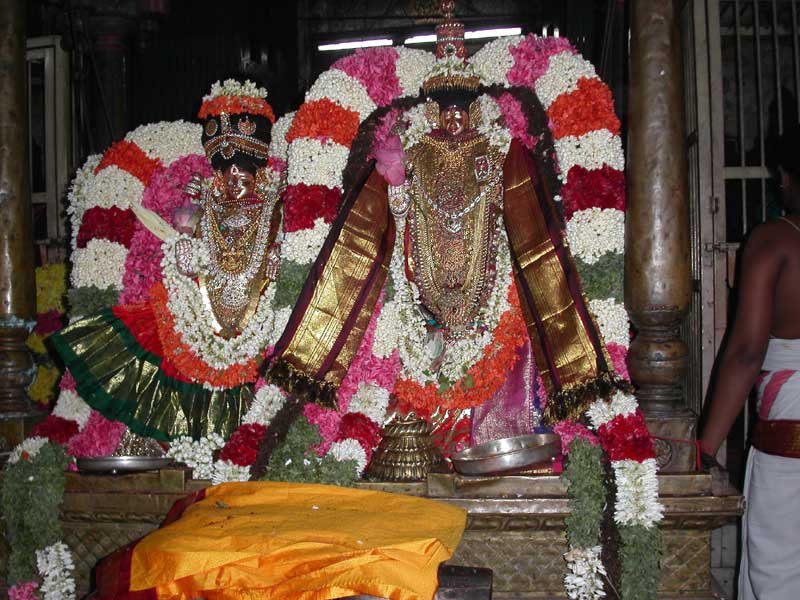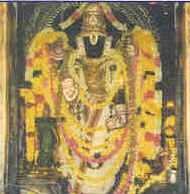
We are fortunate to worship Sri Thayar and the Lord. Ahindrapuram is the Kshetram built and worshiped by Adisesha. We will see the connection between the servant [சேஷ] Adisesha and this place. From the sthala purana, it is evident that the Lord appeared to sage Markandeya and Sri Bhudevi. The Lord here has many names: Sri Devanatha, Sri Trimurthi, Sri Dasa Sathya, Sri Adiyavarku Meyyan [ஸ்ரீ அடியவர்க்கு மெய்யன்] and Sri Achyuta. Thirumangai Alwar has praised this Kshetram in Ten poems. Once a war broke out between Devas and Asuras. As advised by lord Brahma, Devas approached the Lord Sri Maha Vishnu for help. The Lord helped and destroyed Asuras and so He is called Sri Devanatha. Thirumangai Alwar, while praising, has considered Him as the Trinity. So, the Lord has incorporated, the Trinity in Him. The pasuram is 'eralum iraiyonum, thisaimuganum, thirumagalum, kooralum thani udamban..' [ஏராளும் இறையோனும், திசை முகனும், திருமகளும், கூறாளும் தனி உடம்பன்]. Thus He is called Sri Trimurthi. During the war, Devas felt thirsty. The Lord also wanted water. Garuda went in one direction to fetch water from Viraja river near Vaikuntam. But Adisesha knew this place thoroughly and so by a blow of his tail on the ground created a water source. It is now called Sesha Theertham [சேஷ தீர்த்தம்]. Adisesha gave water to the Lord. Soon, Garuda also returned with Viraja water and requested the Lord to accept that also. That water is flowing now as Garuda nadhi [கருட நதி]. Today the name has mutilated to Gedila nadhi [கெடில நதி]. We can worship Sesha theertham in the temple itself. It is in the form of a well. Devotees pray for all happiness and curing of their ailments; and, drop salt, jaggery and pepper in this well. We can also see Adisesha in a serpent form. Indra once started to kill Vrittarasura. But he could not succeed. He came to Aushadagiri, on top of which Sri Hayagriva is gracing, and hid himself in the stem of a lotus flower in the pond there. The Lord taking pity on Indra, presented weapon Vajra, made from the back bone of His devotee, sage Dadichi. Indra was able to vanquish the enemy. We will now worship the Lord.





Moolavar is large and is in standing pose, with upper arms holding discus and conch, lower right arm in abhaya mudra and left arm on His lap. Utasavar displays abhaya and holds the mace and is accompanied by Sri Ubhaya Nachiyars. Every Saturday the Lord is in procession; and every Friday, Sri Thayar is in procession. Swami Vedanta Desika has praised the Lord's every organ like the face, the Divine feet, the Crown, etc. While praising the Crown, he says that the radiance of the Crown, which is like a billion Suns luminescence, should remove the darkness of ignorance in his heart. Sri Thayar is Sri Senkamalavalli, aka Sri Hemabjanayaki. Her Divine grace will remove all our sins. Sri Thayar is also known as Sri Bhargavi. Sage Brighu, meditated for long and prayed that Sri Thayar should be his daughter, and so She is called Sri Bhargavi. Thirumangai Alwar addresses the Lord as Sri Adiyavarku Meyyan [ஸ்ரீ அடியவர்க்கு மெய்யன்]. In Sanskrit this is called Sri Dasa Satya. He is always supporting the devotees. We will now see the introduction to Chapter 11. In Chapters 7, 8 and 9 Bhakti yoga was explained. To answer what stimulates Bhakti, the Lord explained His eminence and His wealth. In his Gitartha Sangraha, Swami Alavandar gives the essence of Chapter 11:
ek¯ada´se sva y¯ath¯atmya s¯aks.¯atk¯ar¯avalokanam |
dattamuktamvidipr¯aptyoh.bhaktyekop¯ayat¯a tath¯a || [15]
Ekadase = in Chapter 11, sva yathatmya = the Lord's eminence and magnificence, His wealth and auspicious qualities, sakshatkara avalokanam = to understand it as it is and properly. Here, the word avalokanam means not scene but eyesight. In order to see properly the Lord's greatness. Dattam uktam = [Arjuna was] blessed with appropriately. Arjuna was blessed with the Divine power to see for himself the Lord's grandeur. What is the necessity to grant Arjuna this power? Was he not seeing Sri Krishna with his ordinary eyes? Uktam means it was stated. That is Divine eyesight given was stated. Because, Arjuna did not possess the superior eyesight to view the Lord's real form; the eyes he had could see only earthly ordinary things. This new superior eyesight was needed to see all the great things he heard from the Lord in Chapter 10.
When normal humans tell about their wealth, we might like to verify by seeing them. But if a King boasts of his enormous wealth and troops, one would be eager to have a glimpse of it. Like this Arjuna had the eagerness to see the wealth of the Lord. He wanted to see Adityas, the stars, the Vedas, etc., as part of the Lord. His normal eyes would only reveal the Lord's human form as Sri Krishna. Our eyes have limitation. But to view the Lord in His true perspective, superior eyes were needed. After granting, Arjuna could see the mammoth form of the Lord -the Viswaroopa. Arjuna had seen the Lord as a Cowherd, as teaser of Gopikas, as the mischivous Boy of Gokulam, etc; but what he saw after the Divine power of sight was granted, was something one could not imagine. Sanjaya, who was narrating the battlefield happenings to Dhridarashtra, also got this power to see, with the blessings of his Acharya, Vyasa. Vidi praptya = knowledge [about the Lord] obtained [it is also called gyana darsana parapti, or understanding the Lord, seeing the Lord and reaching Him - para bhakti, para gyana and parama bhakti stages]. Bhakty = devotion, eka = only, upayata = means. To understand, to see and to reach Him, Bhakti is the only means. Thus in Chapter 11, Arjuna got the divine vision to see the Lord with all the wealth and auspiciou qualities, and further, he was told that Bhakti alone was the only means to understand, to see and to reach Him. We will now take leave of the Kshetram.
No comments:
Post a Comment